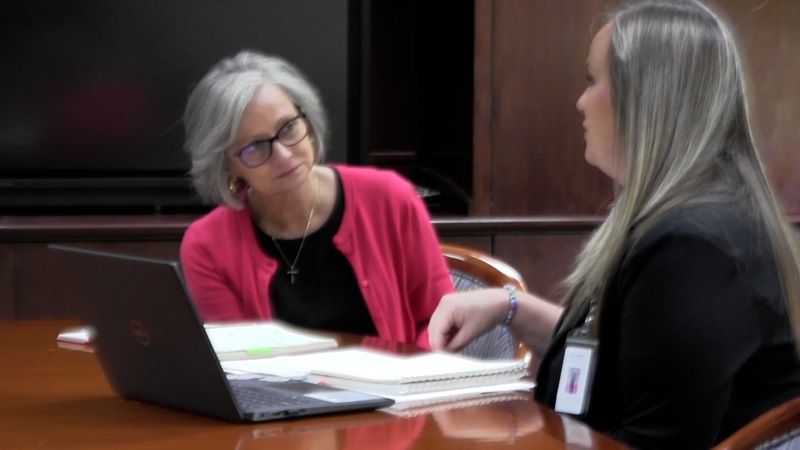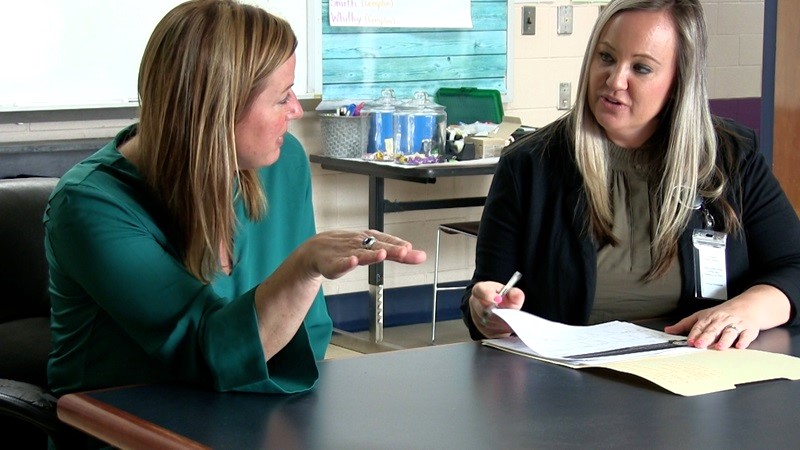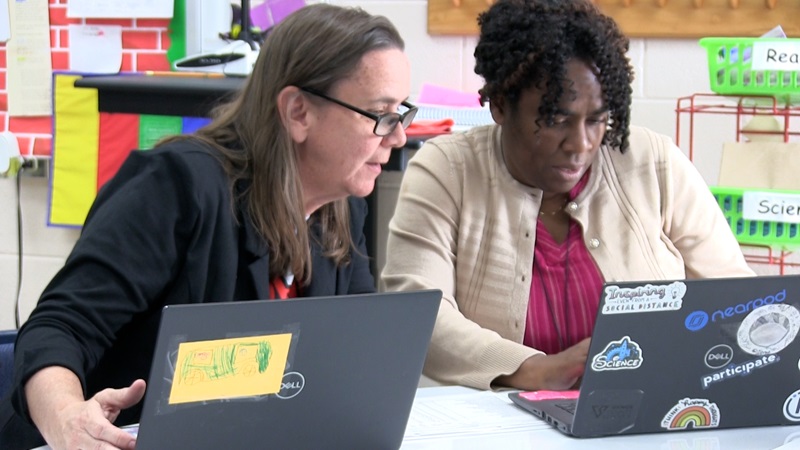Before Vance County Schools began designing its Opportunity Culture® staffing models in 2017–18, the district struggled with teacher turnover and higher pay supplements offered by nearby districts. Based in Henderson, N.C., the district began implementing the models in three elementary schools the following year to serve as “incubators of innovation” before expanding into four more schools. How has the district’s implementation not only been sustained but also thrived, through superintendent turnover and a pandemic?
Listen to our companion audio piece:
For N.C. Superintendent, Opportunity Culture® Teams Lead to a “Return on Instructional Investment”
“This is year seven for us now, and that’s exciting because a lot of times in education, we see initiatives come through or programs come through and then they fizzle out, but here we are and we’re actually growing…that is definitely a success for us,” Casey Jackson said. Jackson began driving from her home in Virginia to Aycock Elementary, one of the initial three schools, to serve in the Multi-Classroom Leader® role, leading a small teaching team. She now serves as the district’s advanced teaching roles coordinator overseeing implementation across the district.
“I would also say that we are growing our people, we’re growing our leadership—their capacity with the training that they’re getting—and continuing to have that growth mindset,” Jackson said. And she kept going about success: “We have schools meeting and exceeding growth, and when it comes to student learning, that’s number one, so we are excited about that. Teachers are growing, and they want that growth…so, to know that the teachers value it is a success in my book….Relationships are being built, and that’s always a success. Collaboration…it’s definitely a success for our whole district; we are now collaborating across schools…we have teachers collaborating with teachers at other schools, we have leadership collaborating more—it’s just nice to see.”
Jackson, Aycock Principal Kristen Boyd, Multi-Classroom Leader® Stephanie Black, and Superintendent Cindy Bennett have all seen how the district has sustained these models. Bennett directed the work as an assistant superintendent under former superintendent Anthony Jackson, who brought the models to the district; he became superintendent of Chatham County Schools in central North Carolina, which plans to implement Opportunity Culture® models in the fall. Boyd embraced the models as Aycock principal from the start, as did Black, both working closely with Casey Jackson as the school designed its initial plan and tweaks it each year to meet students’ needs and educator staffing.
In interviews, they identified some keys to sustainability in the district, with a focus on Aycock’s sustained implementation and learning growth results:
- Strong support for the model from administrators, at both the district and principal levels
- Protected time for teaching team leaders and team collaboration
- Ongoing review of what works: reviewing data and resources every year to redesign implementation to fit the school’s needs—including stopping what doesn’t work
- Support from teachers: because of strong relationships and teacher support from Multi-Classroom Leader® (MCL™) teams, teachers embrace—even demand—this innovative staffing model
- Support through coaching and feedback at all levels—for team teachers, team leaders, and principals



Vance County educators collaborate at all levels. From left to right, Cindy Bennett and Casey Jackson; Kristen Boyd and Casey Jackson; and Stephanie Black and team teacher, Stephanie Sewell-Brown.
Strong Administrative Support
Strong administrative support that cascades down from the top has been a key piece of success.
“Having a superintendent that supports this was huge,” Boyd said—both initially under Anthony Jackson and now with Bennett.
For Bennett, the support must come throughout the district offices. “It cannot be a superintendent-driven initiative…for Opportunity Culture specifically to work, it cannot be owned by the curriculum director, it cannot be owned by a couple of principals—it has to be part of the core work at the district, because coaching and teacher support is a priority for every district. No matter how your students are performing, we all have new teachers—new to the country, new to the district, new to the school, new to the content, new to the grade level. And new teachers need to be supported, and this is probably the best, most effective way that we can support and retain high-quality teachers.”
So, Bennett said, that means having human resources staff understand why the team leaders have a different interview process, and having finance staff understand the importance of how they set pay supplements for the team roles.
Bennett speaks often of focusing on their return on investment: “It really is about helping everyone around the table to understand the impact… and then it just flows,” she said. By embedding procedures and practices used in the model in their leadership meetings, everyone knows “that it’s not just for a couple of schools who use a model—it’s because it’s best practice, it’s research-based, and we’re getting the impact and the results that we want.”
Continuing that cascade is the district-level director role.
The model fits with the district’s strategic plan pillar of being a high-performing organization, but it needed support, making it important to hire Casey Jackson, who also had experience as a principal before coming to Vance. Along with supporting teachers in Opportunity Culture® roles, Jackson has been a great support to their principals, Bennett said. “There was a gap between our OC™ model schools and [district] instructional staff, and having this position has really bridged that gap, and now, it’s everyone working for the same purpose—everyone working to truly support teachers, enhance instruction, and focus on the lesson execution.”
Then, Bennett said, the principal is pivotal.
At Aycock, Boyd “is a leader who understands the model so intently and holds others accountable for it with such fidelity that if she were to walk away today, it is embedded in the culture of the school. It would continue,” Bennett said. “And other schools and other teachers are saying ‘that’s the place to be, that’s where I want to work. I know how hard they are working; I see what they are doing but I also see the joy that the return on the investment of instruction is making.’”
Protected Time for Teaching Team Leaders and Team Collaboration
Black and her MCL™ colleagues have time to plan individually before their team planning and data meetings, leading to focused meetings. “I think I’m not dilly-dallying when I meet with them, like, I know exactly what I’m going to do instead of wasting their time,” Black said.
Administrators, she said, “make sure that our time is secured to work with our teachers, that we are not pulled to do other things—that’s huge.”
Data from the national initiative shows that this protected time is associated with high student growth.
The team leaders’ time is too valuable to spend covering for staff absences or taking on unrelated duties, Bennett said. “I think they know that we respect what they’re doing, and as I’ve said to principals, if you really see the value in this work, then we must act that way, and that means that you do not take them away from their primary responsibility. I think at Aycock, even when the principal might have had to go and cover a class waiting for a substitute, she felt comfortable doing that.”
Boyd agreed. Team leaders “are needed in that classroom; they’re needed with those teachers. When they’re here, I want other people to see the value of why we’re spending our money on them—they’re in the work right beside you, and if you’re in an office or you’re doing something else, what are we doing this for?”
Ongoing Review of What Works
“Over the years, we really look at what worked and what didn’t work, and then we adjust,” Black said.
Static plans will not lead to ongoing success, she and other Vance educators say. Schools must review data and resources every year to redesign their implementation to fit the school’s current needs—including stopping what doesn’t work.
“You have to know your staff, and throughout the year we are always reflecting on which leader would work best with this teacher—you’re constantly redesigning throughout because each leader has different qualities and different strengths as well,” Boyd said. “I want to continue to grow, and I also want to grow the teachers that are in this classroom, and they may not stay in that grade level. We have flipped teachers around and moved them, and I’m also trying to encourage them to build other leaders.”
Every year, Boyd reconsiders the funding she has and positions she needs; for example, she may trade a vacant teaching position to fund several paraprofessionals to support teaching teams, and the school is willing to accept slightly bigger classes as a tradeoff for MCL™ support.
“I would rather have a strong, solid teacher in the classroom with a strong coach working with all of those children, than just to have a strong teacher and then possibly a brand-new teacher that has no idea what’s going on and two small classes,” Boyd said. That tradeoff is further offset by the power of small-group instruction made possible with teaching teams, allowing teachers to meet each student’s needs, she said.
If the district takes care in recruiting, hiring, and holding team leaders and principals accountable, “you will get the results,” Bennett said.
Support from Teachers
Because of strong relationships and support through the teaching teams, teachers embrace—even demand—this innovative staffing model.
“I think the teachers believe in it—we build relationships, they know that their kids are my kids,” Black said.
Teaching teams make significant collaboration and small-group instruction possible, Black said, providing that deep support. As a single classroom teacher, “I wasn’t ever really talking to another teacher, especially if they were just math and I was reading…Now we have to, and we want to.”
Before, she said, “I would do my best to try and look at the data, but when you’re teaching from 7:30 to 3:30, you don’t know the ins and outs of all of that data. You just don’t have time.”
Now, Black has the time to analyze the data for the entire team, teaching them in the process how to better do it themselves.
In the end, she said, implementation has stuck and keeps improving “because we are seeing results, so then, [teachers] are buying into it more and more. Teachers want feedback, teachers want it. I mean, if you’re doing it with good intentions and you’ve got that relationship, they’re like, ‘what went well; what do I need to work on?’”
Support Through Coaching and Feedback at All Levels
Everyone needs support, from team teachers to team leaders to principals.
“If you come here, you have a tremendous amount of support from our coaching,” Boyd said. “The model helps us with being able to provide support in the classroom through co-teaching and just having someone in there with you—where I can’t get to every teacher in this building very quickly, but you have a leader that’s there and can get them what they need, sit down and plan with them, help them with the data.”
That has been especially valuable for newer teachers, she said, who often did not get teacher training in college. And the difference after Opportunity Culture® implementation was stark.
“Prior to 2017, we were losing teachers because of the lack of support. [Now,] we have invested coaches, leaders that have continued to stay, and they enjoy the role. They like being able to go in and work with teachers, they like being able to teach students, they like being in front of small groups. They like being a part of the instructional leadership team, and we meet every week and they are invested in this model.”
Along with their regular meetings with Boyd, the team leaders get crucial support from the district through Jackson.
“She’s done a great job with trying to provide the monthly coaching meetings, and they work on different things—she sees the needs,” Boyd said. “They had a session the other week on data, and she puts everything she has into her professional development with them.”
Professional learning is a district focus, Bennett said.
“Personalizing our professional development is something that we’re really working diligently on, because our teachers aren’t widgets, and neither are our kids. We talk a lot about personalized learning for our students—we have to do personalized professional learning for our staff. And this [model] is something that does that for us, because you have your own coach who knows you very well and can connect you with either others on your team or others in the building or someone in another school who might be able to add some value to some of the things that you are doing.”
As their MCL™ staff has grown, Bennett sees cross-school collaboration as well. “That’s collaboration at its finest, and it really tears down a lot of walls of competition. It really is about ‘everyone needs to be coached up,’ and that’s what we’re trying to do.”
